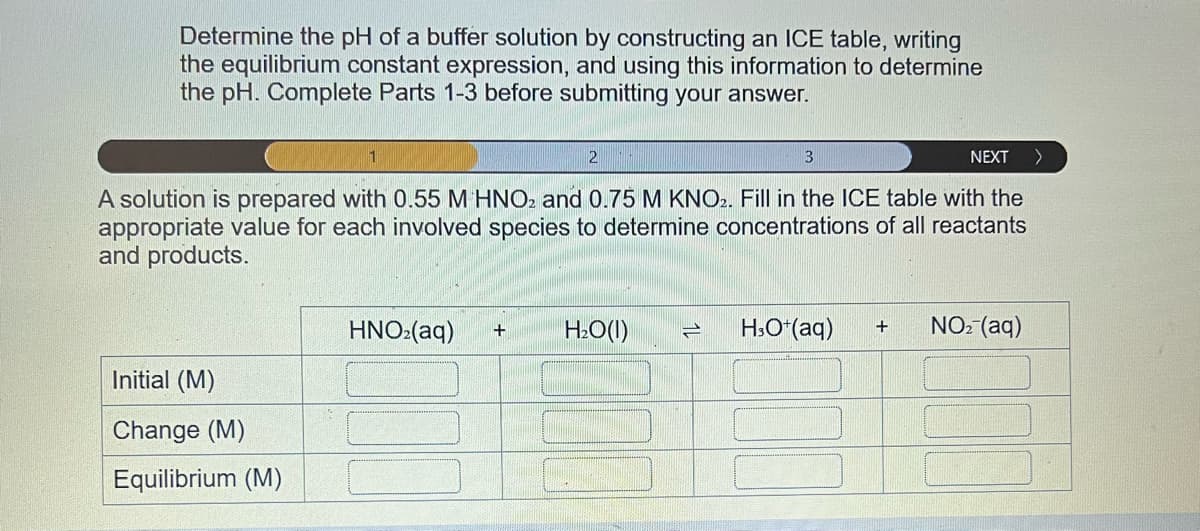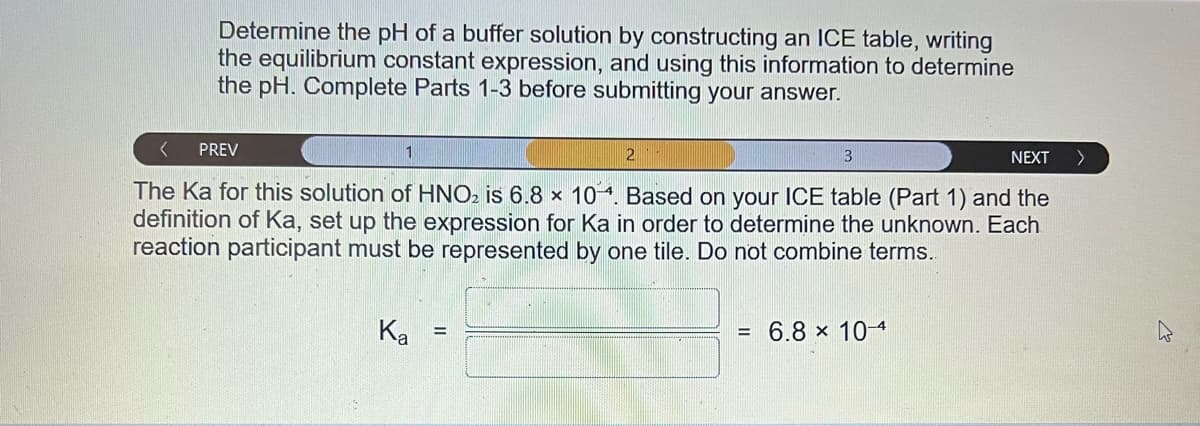Determine the pH of a buffer solution by constructing an ICE table, writing the equilibrium constant expression, and using this information to determine the pH. Complete Parts 1-3 before submitting your answer. 1 NEXT > A solution is prepared with 0.55 M HNO2 and 0.75 M KNO2. Fill in the ICE table with the appropriate value for each involved species to determine concentrations of all reactants and products. Initial (M) Change (M) Equilibrium (M) 2 HNO₂(aq) + H₂O(l) 1 3 H3O+ (aq) + NO₂ (aq)
Determine the pH of a buffer solution by constructing an ICE table, writing the equilibrium constant expression, and using this information to determine the pH. Complete Parts 1-3 before submitting your answer. 1 NEXT > A solution is prepared with 0.55 M HNO2 and 0.75 M KNO2. Fill in the ICE table with the appropriate value for each involved species to determine concentrations of all reactants and products. Initial (M) Change (M) Equilibrium (M) 2 HNO₂(aq) + H₂O(l) 1 3 H3O+ (aq) + NO₂ (aq)
Chemistry: Principles and Reactions
8th Edition
ISBN:9781305079373
Author:William L. Masterton, Cecile N. Hurley
Publisher:William L. Masterton, Cecile N. Hurley
Chapter14: Equilibria In Acid-base Solutions
Section: Chapter Questions
Problem 80QAP
Related questions
Question

Transcribed Image Text:Determine the pH of a buffer solution by constructing an ICE table, writing
the equilibrium constant expression, and using this information to determine
the pH. Complete Parts 1-3 before submitting your answer.
NEXT >
A solution is prepared with 0.55 M HNO2 and 0.75 M KNO2. Fill in the ICE table with the
appropriate value for each involved species to determine concentrations of all reactants
and products.
Initial (M)
Change (M)
Equilibrium (M)
1
2
HNO₂(aq) + H₂O(l) 1
3
H3O+ (aq) + NO₂ (aq)

Transcribed Image Text:Determine the pH of a buffer solution by constructing an ICE table, writing
the equilibrium constant expression, and using this information to determine
the pH. Complete Parts 1-3 before submitting your answer.
< PREV
3
The Ka for this solution of HNO₂ is 6.8 x 104. Based on your ICE table (Part 1) and the
definition of Ka, set up the expression for Ka in order to determine the unknown. Each
reaction participant must be represented by one tile. Do not combine terms.
Ka
=
2
= 6.8 x 10-4
NEXT
>
Expert Solution
This question has been solved!
Explore an expertly crafted, step-by-step solution for a thorough understanding of key concepts.
This is a popular solution!
Trending now
This is a popular solution!
Step by step
Solved in 3 steps with 3 images

Knowledge Booster
Learn more about
Need a deep-dive on the concept behind this application? Look no further. Learn more about this topic, chemistry and related others by exploring similar questions and additional content below.Recommended textbooks for you

Chemistry: Principles and Reactions
Chemistry
ISBN:
9781305079373
Author:
William L. Masterton, Cecile N. Hurley
Publisher:
Cengage Learning


Chemistry: An Atoms First Approach
Chemistry
ISBN:
9781305079243
Author:
Steven S. Zumdahl, Susan A. Zumdahl
Publisher:
Cengage Learning

Chemistry: Principles and Reactions
Chemistry
ISBN:
9781305079373
Author:
William L. Masterton, Cecile N. Hurley
Publisher:
Cengage Learning


Chemistry: An Atoms First Approach
Chemistry
ISBN:
9781305079243
Author:
Steven S. Zumdahl, Susan A. Zumdahl
Publisher:
Cengage Learning

Chemistry
Chemistry
ISBN:
9781305957404
Author:
Steven S. Zumdahl, Susan A. Zumdahl, Donald J. DeCoste
Publisher:
Cengage Learning


Chemistry: Principles and Practice
Chemistry
ISBN:
9780534420123
Author:
Daniel L. Reger, Scott R. Goode, David W. Ball, Edward Mercer
Publisher:
Cengage Learning